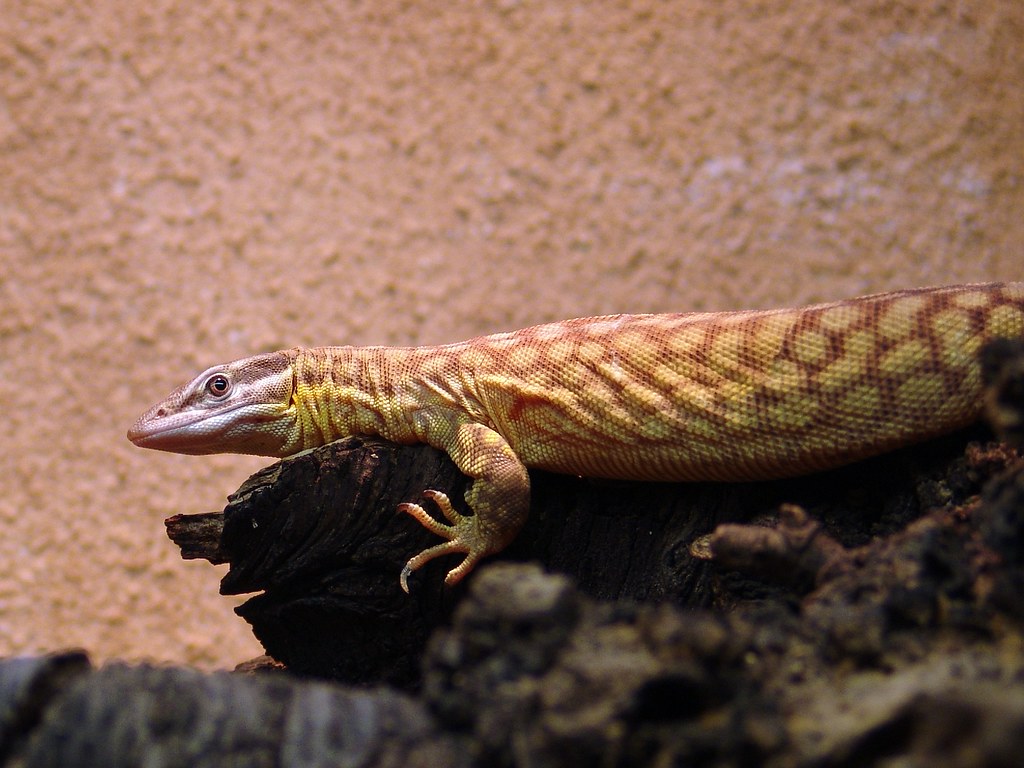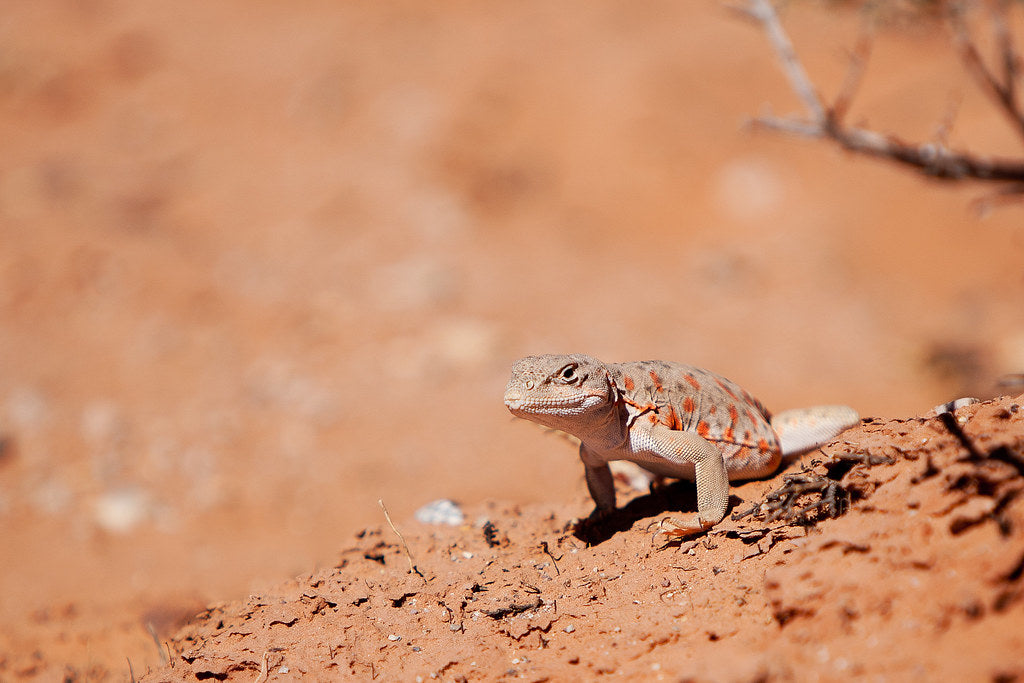Ackies (Varanus acanthurus) are medium-sized, diurnal, terrestrial lizards native to the northwest quadrant of Australia. They can be found in arid/seasonally dry areas with plentiful rock cover and sparse vegetation.
Ackie monitors generally have a slim build with round bellies. They have a long neck, long tongue, long claws, long tail, and a sharply tapered head. Pattern involves two or three dark stripes along the neck, a ringed tail, and a ringed pattern on the back. Coloring varies based on local soil color, but it’s usually dark red or brown with pale markings.
Due to their manageable size as a dwarf monitor, ackies are among the most popular monitor lizards in the pet trade. They also tend to tame down well and have engaging, inquisitive personalities. This is an intermediate-level pet reptile, and with good care, they can live for at least 15 years.
How much space do ackies need?
A single ackie monitor should be housed in no smaller than a 5’L x 2.5’W x 4’H enclosure. This may seem excessive for such a (relatively) small lizard, but it’s important to keep in mind that they need a very deep substrate layer, and as monitor lizards, ackies are quite active. If you can provide a larger enclosure, do it!
As a general rule, it’s best not to house more than one ackie monitor per enclosure.
Do ackies need UVB?
Yes! Ackie monitors are diurnal, which means that they are most active during the day, and naturally exposed to lots of sunlight on a day-to-day basis. This means that they need UVB light as part of their enclosure. The best UVB bulbs for an ackie housed in a 5’ long enclosure are:
- Zoo Med Reptisun T5 HO 10.0, 34”
- Arcadia Desert 12%, 34”
If the UVB is mounted over mesh, then the basking surface should be placed so the ackie’s back will be 7-9” below the lamp. If the UVB is mounted inside the enclosure, then the basking surface should be placed so the ackie’s back is 12-15” below the lamp. The UVB bulb should be housed in a reflective fixture like Arcadia or Vivarium Electronics, and placed on the basking side along with the heat lamp. UVB bulbs decay over time, so you will need to replace yours every 12 months to maintain performance.
In addition to UVB, since ackie monitors are day-active lizards, it’s beneficial to provide an additional daylight-spectrum lamp to make sure most of the enclosure is brightly illuminated. Use a couple of strong 6500K LED or T5 HO fluorescent plant grow lights for best results.
Ackie monitors should get 13 hours of light per day during summer and 11 hours of light per day during winter. This simulates natural seasonal changes in day length and encourages healthier hormonal rhythms.
What basking temperatures do ackies need?
Ackie monitors like it hot! They should have a basking surface temperature between 158-172°F, with cool side temperatures down to 75-82°F. Average ambient air temperature should be around 85°F. Nighttime temperatures can drop as low as 65°F, which can usually be accomplished by turning off the heat source. Measure your temperatures with a temperature gun.
Provide heat for your ackie by imitating the sun with a cluster of at least two high-wattage halogen heat lamps placed on one side of the enclosure. Do not use ceramic heat emitters (CHEs), heat mats, red bulbs, or blue bulbs, as these are not as effective.
The basking surface itself should be a large, flat piece of rock. For best results, use a Retes stack.
What humidity levels do ackies need?
As an arid species, ackie monitors don’t need much in the way of humidity — above ground, anyway. Average air humidity should stay between 20-50%, but it’s essential to provide your ackie with access to a humid hideout or burrow with humidity levels of 80%+.
To create this humid microclimate, occasionally pour water directly into the substrate with a watering can or similar. Keep track of humidity levels above and below ground with a couple of digital probe hygrometers.
What substrate is good for ackies?
Substrate covers the floor of your lizard’s terrarium and helps make the enclosure more attractive, but it also helps maintain desired humidity levels and provides something for your lizard to dig around in.
It’s ideal to use a substrate that imitates the “substrate” that the reptile naturally lives on in the wild. For ackies, that means sand or very sandy soil. We recommend the following substrates for ackie monitors:
- Zoo Med ReptiSand
- Exo Terra Desert Sand
- Play sand
Substrate should be at least 12” deep and completely replaced every 3-4 months. Remove poop and urates daily, along with contaminated substrate.
What décor can you use in an ackie terrarium?
Ackie monitors are active animals and quite intelligent, so they get bored easily. Using a large enough enclosure is the first step toward preventing this, but it’s also important to provide enrichment to help keep them busy and entertained. It doesn’t matter how big the enclosure is if you don’t put things in it for your pet to use and interact with.
Although a basking platform, burrow/hiding place, and water dish are absolutely required, it’s a good idea to add other things to the enclosure. Here are some ideas:
- more hiding places
- ledges
- hollow logs
- branches
- live or artificial plants
- small dried shrubs
What do ackies eat?
Ackie monitors are insectivores, and they need a varied diet of invertebrate prey (preferably live) in order to get the nutrition that their bodies need. Offer food every morning. Juveniles should get as much as they can eat in one day, but subadults and adults should only be allowed as much as they can eat in a 5-10 minute period.
Feeders should be no wider than the lizard’s head.
Invertebrates for ackie monitors: dubia roaches, discoid roaches, red runner roaches, crickets, black soldier fly larvae, hornworms, silkworms, mealworms, superworms, darkling beetles, grasshoppers, scorpions, centipedes, giant isopods
Supplements
You will also need calcium and vitamin supplements to prevent your ackie from developing a deficiency. We recommend Repashy Calcium Plus LoD, lightly dusted on all feeder insects.
Water
Although ackies are desert reptiles, they still need access to fresh water. Provide a small water bowl where your lizard can always get a drink when needed. Change the water daily and scrub the bowl with a reptile-safe disinfectant weekly, or whenever it becomes soiled.
Do ackies like to be handled?
Few reptiles actually “like” to be held, but ackie monitors can become quite tame with persistent effort. They tend to be quite flighty as youngsters, but become more confident as they mature.
When handling your ackie monitor, let them come to you whenever possible. Use slow movements, and never grab them from above or pull them out of a hiding place. Use slow movements, and only gently restrain them.
One great way to interact with your ackie instead of handling is though hand-feeding with a pair of feeding tweezers!
This care sheet contains only very basic information. Although it’s a good introduction, please do further research with high-quality sources to obtain additional information on caring for this species. Here are some great sources to get you going in the right direction:
"varanus acanthurus" by Joachim S. Müller is licensed under CC BY-NC-SA 2.0




Leave a comment
This site is protected by hCaptcha and the hCaptcha Privacy Policy and Terms of Service apply.